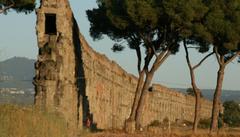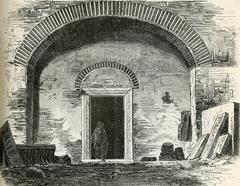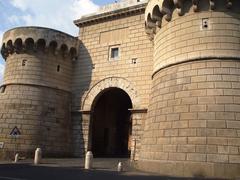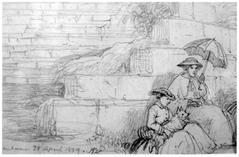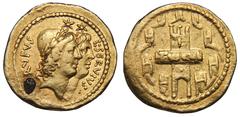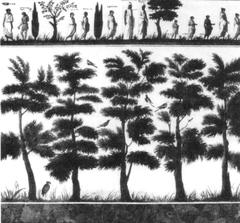Hypogeum of the Garlands: Visiting Hours, Tickets, and Complete Guide to Grottaferrata, Italy
Date: 14/06/2025
Introduction
Nestled in the verdant Alban Hills near Rome, the Hypogeum of the Garlands (Ipogeo delle Ghirlande) in Grottaferrata stands as a rare testament to the funerary art and customs of Rome’s elite during the transitional period from Republic to Empire. Dating from the 1st century BCE to the 1st century CE, this underground tomb is celebrated for its remarkably preserved occupants, intricate garland-decorated interiors, and extraordinary artifacts—most notably, a gold ring with a holographic quartz crystal. The hypogeum’s discovery has provided invaluable insights into ancient embalming, burial rituals, and the complex social fabric of Roman society (Scientific Reports; NCBI PMC; My Modern Met).
Due to its fragile state, direct access to the hypogeum is limited. However, Grottaferrata’s museums, virtual reconstructions, and guided tours offer visitors rich opportunities to explore this unique archaeological treasure and its broader historical context, including the famed Abbey of Santa Maria di Grottaferrata and the ancient ruins of Tusculum. This guide provides a comprehensive overview of the Hypogeum of the Garlands, covering its origins, cultural significance, visitor information, and nearby attractions.
Table of Contents
- Introduction
- Origins and Discovery
- Architectural Features and Layout
- Historical and Cultural Significance
- Archaeological Findings
- Visiting Information: Hours, Tickets, and Accessibility
- Nearby Attractions and Travel Tips
- FAQs
- Conclusion and Recommendations
- Further Resources
Origins and Discovery
The Hypogeum of the Garlands is a subterranean family tomb excavated from the tufa bedrock of the Alban Hills near Grottaferrata. Dating to the late Republican or early Imperial Roman period, it was uncovered in 2000 during systematic excavations of the Grottaferrata necropolis. Its proximity to the Via Latina and the ancient city of Tusculum underscores the area’s status as a prestigious burial ground for Rome’s elite (Scientific Reports; Grottaferrata Tourism).
Architectural Features and Layout
The hypogeum comprises a single, airtight chamber with niches for urns and two prominent marble sarcophagi. Its walls and ceiling are adorned with stucco and frescoes depicting vegetal garlands—symbols of eternity and familial remembrance. Benches (klinai) are integrated into the layout, likely serving ritual functions during funerary ceremonies. The artistry and design reflect a blend of Roman, Greek, and Etruscan influences, emphasizing both lineage and social status (My Modern Met).
Historical and Cultural Significance
Emerging during a period marked by evolving funerary traditions, the Hypogeum of the Garlands illustrates the transition from cremation to inhumation, influenced by Eastern Mediterranean beliefs. The tomb’s lavish decor and valuable grave goods signify the aristocratic status of those interred within, specifically Aebutia Quarta and her son Carvilius Gemellus. The inclusion of floral garlands and rare embalming techniques highlights the diversity and sophistication of Roman burial practices (NCBI PMC; PubMed).
Archaeological Findings
Key discoveries from the hypogeum include:
- Carvilius Gemellus: An 18-year-old male, whose mummified body was preserved through advanced embalming, a rarity in Roman burial (NCBI PMC).
- Aebutia Quarta: His mother, aged 32–43, whose skeletal remains were adorned with perfectly preserved flower garlands, offering insight into Roman rituals and floral symbolism.
- Third Individual: Cremated remains of a male aged 40–50, signifying the coexistence of cremation and inhumation.
- Artifacts: Highlights include the gold ring with a carved quartz crystal that projects a three-dimensional image—an example of exceptional Roman craftsmanship (My Modern Met; The Archaeologist).
Ongoing research and advanced scientific methods such as spectroscopic analysis continue to reveal details about embalming substances, burial customs, and social hierarchies (CREF).
Visiting the Hypogeum of the Garlands: Hours, Tickets, and Accessibility
Access:
Due to its delicate preservation, the Hypogeum of the Garlands is not open for general public visits. Access is limited to scheduled guided tours or special open days arranged by local heritage authorities.
-
Guided Tours and Virtual Experiences:
Information and immersive experiences related to the hypogeum are available at the Grottaferrata Archaeological Museum and through digital platforms. Virtual tours and digital reconstructions provide a detailed look at the tomb’s interior and its artifacts (Audiala). -
Booking and Tickets:
Advance booking is essential for any available tours. Ticket prices vary depending on the event, typically ranging from €10 to €20. Visit the Grottaferrata Tourism website or contact local tourism offices for the latest details. -
Visiting Hours:
Special tours and events are usually held from April to October. Confirm dates and times through official sources. -
Accessibility:
The hypogeum itself is accessed via stairs and is not fully accessible to visitors with mobility challenges. Museums and visitor centers in Grottaferrata, however, generally provide accessible facilities.
Nearby Attractions and Travel Tips
While in Grottaferrata, visitors can explore a wealth of cultural and natural attractions:
- Abbey of Santa Maria di Grottaferrata:
A historic Byzantine abbey, open Tuesday to Sunday, 9:00 AM–5:00 PM. Guided tours are available and highly recommended (Welcome Rome). - Tusculum Ruins:
Explore the remains of the ancient city, offering panoramic views and a tangible link to Rome’s past. - Frascati and the Alban Hills:
Enjoy scenic landscapes, local wines, and traditional cuisine in nearby towns. - Annual Fiera Nazionale di Grottaferrata:
A vibrant festival featuring crafts, food, and regional traditions.
Travel Tips:
- Book tours in advance, especially for the hypogeum and abbey.
- Wear comfortable footwear and bring a jacket for underground or museum visits.
- Use public transportation from Rome (train to Frascati, then bus/taxi to Grottaferrata) or drive via Via Anagnina or Via Tuscolana.
Frequently Asked Questions (FAQ)
Q: Can I visit the Hypogeum of the Garlands directly?
A: Direct access is restricted. Visitors can learn about the site through museum exhibits, virtual tours, and special guided events.
Q: How do I book tickets for the hypogeum or the abbey?
A: Tickets for the abbey can be purchased on-site or online. Hypogeum tours require advance booking through local tourism offices.
Q: Are guided tours available?
A: Yes—guided tours for both the abbey and the hypogeum (when available) provide valuable historical context.
Q: Is Grottaferrata accessible for visitors with disabilities?
A: Museums and the abbey offer some accessibility accommodations. The hypogeum itself is not wheelchair-accessible.
Q: What else should I see in the Alban Hills?
A: Don’t miss the Tusculum ruins, Frascati’s wine estates, and local festivals.
Conclusion and Recommendations
The Hypogeum of the Garlands is an archaeological jewel that illuminates the rich funerary traditions and artistic achievements of ancient Rome’s elite. Although direct access is limited, Grottaferrata’s museums, virtual platforms, and expert-led tours ensure that its legacy is accessible to all. Pair your exploration of the hypogeum’s story with visits to the Abbey of Santa Maria di Grottaferrata, the Tusculum ruins, and the scenic towns of the Alban Hills for a complete cultural experience.
Advance booking and participation in guided tours are highly recommended. Stay updated through official tourism channels to take advantage of special openings and events. By immersing yourself in Grottaferrata’s layered history, you gain a deeper appreciation for Italy’s enduring heritage and the intersection of Roman and Byzantine cultures.
For audio guides and further travel inspiration, download the Audiala app and follow related articles on Grottaferrata and Roman antiquities.

